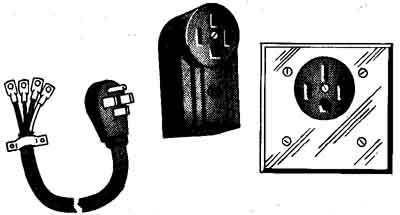Appliance Wiring: Receptacles
| Receptacles are rated in amperes and volts. The volt rating indicates the following restrictions:
The diagram below shows a variety of receptacles labeled A through L. Except for A, all 125-volt and 250-volt receptacles have a third opening for the third prong on a three-prong plug for connection to the equipment grounding wire. The 125/250-volt receptacles I and J have a third opening for the third prong on the plug for connection to the grounded neutral wire of the circuit. Note that a plug that fits A will also fit B or C; a plug made for B will also fit C; but a plug made specially for C won’t fit A or B. All of the other configurations are eon-interchangeable. Diag. above: An assortment of receptacles. Those rated at 15 and 20 amps have a diameter of 1.327 inches. Those rated at 30 and 50 amps have a diameter of 2.12 inches. In the illustrations, the opening marked G is for the equipment grounding wire; the one marked W is for the white circuit wire; those marked X, V or Z are for the hot circuit wires. At A is shown what used to be the typical 15-amp receptacle (usually made in the duplex configuration) and is now used only for replacements. The receptacle at B is the same as A, except it has the third opening for the third prong on a three-prong plug—for connection of the equipment grounding wire. At C is a similar 20-amp receptacle. At D is a 30-amp receptacle for larger 120-volt loads. At E, F, G, and H are shown respectively 15-amp, 20-amp, 30-amp and 50-amp receptacles for loads operating at 240 volts. Note that each is provided with an opening for the equipment grounding prong on a three-prong plug. Caution: That prong and that opening must never be used for a neutral wire if the appliance operates at 120/240 volts rather than at 240 volts. At I and J are shown 30-amp and 50-amp receptacles for appliances operating at 20/240 volts. The 30-amp receptacle is used mostly for clothes dryers, and the 50-amp receptacle for ranges on existing circuits. At K and L are shown three-pole, four-wire, 125/250-volt receptacles for new dryer and range circuits. These are not the only receptacles available. There are dozens of others in two-wire, three-wire, four-wire, and even five-wire types. Besides the ordinary variety, there are others designed so the plug cannot be removed without first twisting the plug to unlock it. Some special-purpose types not used in ordinary wiring are designed so that only a plug and receptacle of the same brand will fit each other. Receptacles come in a variety of mounting methods to fit various boxes and plates, both flush and surface types. The 50-amp receptacle is shown in both the surface- mounting type and flush-mounting type in the diag. below, which also shows a typical plug (on left) with “pigtail” cord attached. These are used mostly in the wiring of electric ranges. A similar 30-amp receptacle is used for clothes dryers. Diag. above: Ranges are connected to 50-amp, 125/250-volt receptacles of the type shown here. The pigtail is connected to the range, then plugged into the receptacle. top of page |

